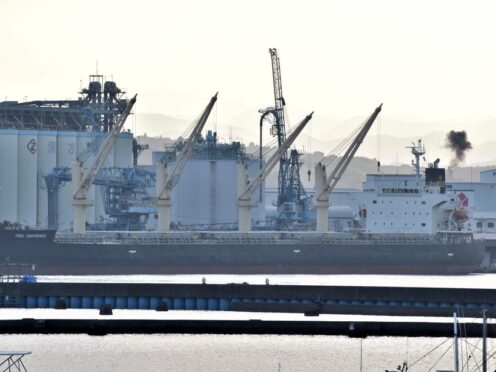
The first fatal attack by Yemen’s Houthi rebels on shipping threatens to further sever a crucial maritime artery for global trade and carries with it risks beyond those at sea.
The White House is already warning there will be a response to Wednesday’s attack on the Barbados-flagged, Liberian-owned bulk carrier True Confidence in the Gulf of Aden.
The US military’s Central Command said an anti-ship ballistic missile launched from a Houthi-controlled area in Yemen struck the commercial ship, causing significant damage.

Three crew members were killed and at least four crew members were injured, with survivors forced to abandon the vessel following the attack, US officials said.
What the US response will look like remains unclear, but it has already launched round after round of airstrikes targeting the Houthis, a rebel group that has held Yemen’s capital since 2014, and more are likely to be on their way.
But there is already a wider economic, humanitarian and political impact looming from the attack.
It also further highlights Yemen’s years-long war, now overshadowed by Israel’s grinding conflict with Hamas in Gaza that may reach into the holy Muslim fasting month of Ramadan, raising the danger of worsening regional anger.
Since the onset of the Houthi attacks, the rebels have framed them as a way to pressure Israel to stop the war, which has killed more than 30,700 Palestinians, according to Gaza’s health ministry.
The war began on October 7 with a Hamas attack in Israel that killed about 1,200 people and took 250 others hostage.
But as shipping companies began avoiding the Gulf of Aden and the Red Sea, the rebels began attacking ships with tenuous, or no ties to Israel or the war.
Meanwhile, US and coalition warships have shot down any Houthi fire that has come near them.
This has left the rebels targeting commercial ships whose only protection has been armed guards, barbed-wire fencing and water cannons — good enough to deter pirates, but not an anti-ship ballistic missile.

Wednesday’s attack underlines the danger to those not even involved in the war. The Houthi missile that hit the True Confidence killed two Filipinos and one Vietnamese national. The Iranian-backed Houthis have not acknowledged these deaths and sought to distance themselves from any consequence of their actions.
“We hold America responsible for the repercussions of everything that happens,” Houthi spokesman Mohammed Abdulsalam wrote online.
Another ship sank this past weekend after being abandoned following a Houthi attack.
Already, the Houthis have attacked at least one ship carrying aid bound for territory they hold.
The Greek-flagged, US-owned bulk carrier Sea Champion had been full of grain from Argentina and was bound for Aden and then rebel-held Hodeida when it was hit in February.
As hunger stalks the Gaza Strip during the Israel war, so too does it still grip Yemen, the Arab world’s poorest country.
“The escalation of the crisis in the Red Sea is likely to worsen the food insecurity situation in Yemen in 2024, exacerbating an already dire humanitarian crisis,” the UN Food and Agriculture Organisation has warned.
Then there are the conflicts gripping East Africa. The World Food Programme issued a warning on Tuesday regarding its operations in Somalia, saying the shipping crisis was hindering its ability to “maintain its regular flow of humanitarian aid”.
In war-torn Sudan, the International Rescue Committee said it had suspended its operations to Port Sudan over hiked costs and other concerns rising from the Houthi attacks.
Then there is the economic pressure. While Israel has described its economy as so far unaffected, the same cannot be said for neighbouring Egypt. Traffic in its Suez Canal linking the Red Sea to the Mediterranean Sea onwards to Europe has dropped by nearly half, according to UN figures.
These shipping fees provide crucial revenue for Egypt’s government, which has allowed the Egyptian pound to rapidly devalue as it reached a deal with the International Monetary Fund to increase its bailout loan. Further economic turmoil could spark unrest in Egypt, less than 15 years on from the 2011 Arab Spring.

Enjoy the convenience of having The Sunday Post delivered as a digital ePaper straight to your smartphone, tablet or computer.
Subscribe for only £5.49 a month and enjoy all the benefits of the printed paper as a digital replica.
Subscribe